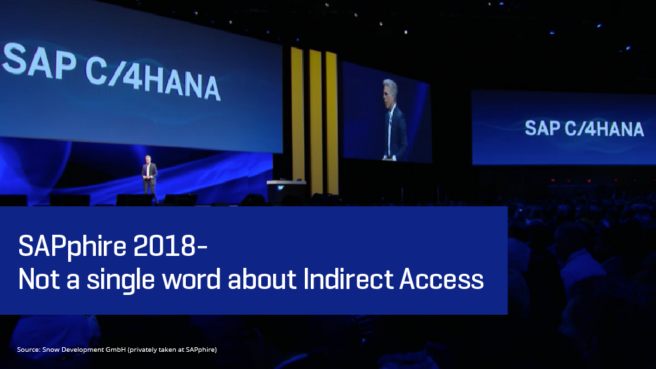SAP positions itself to dominate the CRM market

At the SAPphire 2018 conference, SAP’s main worldwide event for all customers and partners, held in early June in Orlando, Florida, Bill McDermott, SAP CEO, promised a new offering, C/4 Hana, to provide marketing and sales companies a “360 degree view of the actual customer,” to improve sales effectiveness. He also announced a solution for managing data from different sources. Joachim Paulini, Lead Architect for Snow Optimizer for SAP® Software, examines these announcements and how SAP is seeking to differentiate itself.
A New Suite of Solutions to Modernize CRM and a New Data Management Suite
Everything from a single source: SAP announced an offering for sales professionals pitting itself against its old rival – Salesforce. McDermott acknowledged there’s great pressure on organizations to get a single customer view as well as meet stricter data compliance regulations since last month’s enforcement in Europe of the GDPR.
SAP C/4HANA is an integrated offering designed to modernize the sales-only focus giving a 360 view of customer data. However, C/4 Hana is not a new product as such. SAP is combining several solutions under this brand, including acquisitions such as Gigya, Callidus Cloud and Hybris, as well as with solutions developed in-house such as Cloud for Customer. The individual components will not only have a uniform interface, but also access a uniform database.
“SAP was the last to accept the status quo of CRM and is now the first to change it,” McDermott said. “Legacy CRM systems are all about sales; SAP C/4HANA is all about the consumer. We recognize that every part of a business needs to be focused on a single view of the consumer. When you connect all SAP applications together in an intelligent cloud suite, the demand chain directly fuels the behaviors of the supply chain.”
Today, SAP is the undisputed number one for ERP (Enterprise Resource Planning), but it’s a different story when it comes to CRM: Salesforce is ahead with a market share of around 18.8 percent, SAP comes in second with 8.5 percent.
Naturally, customer management is extremely important for SAP, as CRM could contribute more revenue than ERP in the future. The software for customer management is also part of a vision: With the coming of the “intelligent enterprise”, customers should be able to automate routine tasks and make better decisions – thanks to artificial intelligence. This needs to be fueled by as much data as possible.
Another focus was on some Leonardo use cases (SAP Leonardo is the new digital innovation system from SAP) that SAP has been working on since its launch last year.
A big positive for customers was McDermott’s announcement that SAP´s Cloud Platform is now available with the big three public cloud providers: Azure, Google Cloud Platform (GCP) and Amazon Web Services (AWS).
Missing from the keynote was any reference to Indirect Access and licensing. Having been the major topic of 2017’s SAPphire, the topic was nowhere to be seen this year as SAP is trying to move beyond this issue. It can be assumed that SAP thinks their new approach to indirect access announced on April 10, will be sufficient to provide greater transparency embracing a new sales, audit and pricing model.
SAP has taken steps to modernize their pricing approach by moving away from Licensing ERP on Named User Licenses. In this new digital age, ERP is now consumed through interfaces and applications and therefore its new pricing policy must reflect this.
SAP doesn’t (and will likely never) charge for SAP to SAP integrations – a crucial selling tactic for promoting its new C/4 HANA CRM product suite over Salesforce After all, it was the integration between Salesforce and SAP that was at the root of the Diageo Indirect Access case last year in the UK.
Under the new licensing model, SAP identified nine key business outcomes associated with an ERP system, each of which generates what SAP calls a ‘document’ and therefore generates a charge for customers (examples include. An order-to-cash process, which in turn creates a sales document, or a plan-to-produce process which generates a manufacturing document).
With this new optional model SAP customers need to consider one of the following:
- Do nothing (and risk potential fees for Indirect Access)
- Add an addendum to your existing contract and change licensing from Named User Licensing to Digital Objects
- Wholly convert to a new contract, where existing SAP ERP customers licensing S/4 HANA can consolidate old contracts (this is the default contract for any new customers).
Although we are not sure how this will play out, Snow has always maintained the need to create a win-win situation between vendors and licensees. By simplifying complex licensing contractual terms to provide visibility into usage through our solution, Snow Optimizer for SAP Software, Snow’s customers have been able use valuable insights and successfully negotiate better contracts with SAP; having visibility on license compliance, many have realized significant (millions of dollars) cost savings.
We are currently building the new Digital Object measurement tool´s logic into our own solution with the aim to make it easier to use and add more value than the SAP-provided tools, for example: What if-scenarios so you know exactly how much Digital Objects will cost you.
In the meantime, if you want to know more about how Snow Optimizer for SAP Software can mitigate risks around Indirect Access contact us today. Why not also download Four Steps To Reduce Sap® Indirect Access Risk, an essential guide for SAP best practice to ensure you get full visibility of your SAP estate.